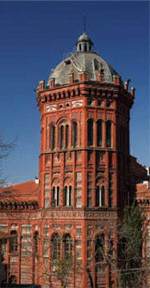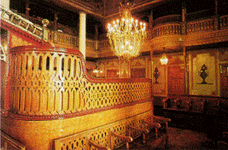Istanbul's Oldest Synagogue: Ahrida
By Büşra İpekçi
Jews, Greeks, Bulgarians, Armenians and Roma have all had a presence there and still inhabit the area in smaller numbers. Due to its formerly predominant Jewish population, Balat developed in a way that reflects Jewish architectural character.
Jews, Greeks, Bulgarians, Armenians and Roma have all had a presence there and still inhabit the area in smaller numbers. Due to its formerly predominant Jewish population, Balat developed in a way that reflects Jewish architectural character.
Today, however, it is a neighborhood populated largely with migrants from the poorer provinces of Turkey. Several fires have ravaged the district over the centuries and many of the places of worship there have undergone major restoration. Balat was once the Jewish quarter, housing thousands of Sephardic Jews after their expulsion from Spain.

They were given refuge by the Ottoman Empire in 1492. Though it once had as many as 19 synagogues, today only two of importance remain: the Ahrida and Yanbol synagogues. İstanbul's oldest synagogue, the Ahrida Synagogue -- also called Okhrida -- is said to take its name from the town of Okhrid in Macedonia, once the origin of many of İstanbul's Jews. It is also considered among the most famous of İstanbul's old synagogues.
The synagogue is on Vodina Caddesi, often called Kürkçü Çesme Sokağı. The original building is thought to have been built in the early 1400s, but a disastrous fire in the 1600s was responsible for extensive damage. In 1694 the sultan issued a decree calling for its reconstruction.
The work was done in the Ottoman Baroque style popular at that time, as exemplified in its wooden dome. Restorations During extensive restoration carried out in 1926 and 1955, original ceiling decorations were discovered. Architect Hitsrev Tayla, in charge of the work, included many of these earlier details in the final plan so as to reflect the synagogue's illustrious history. It also underwent renovation more recently in 1992.
It is a thick-walled building composed mainly of brick and is believed to be built on the remains of separate buildings. A back door uncovered during the restoration may be proof of that, say historians. The synagogue was appropriated by Ottoman armed forces to station soldiers during World War I. The Talmud Torah (primary school), located behind the synagogue, was founded by the Amon family of Balat in 1877, but no longer has any students.
The synagogue's ocara -- a secure chamber for the safekeeping of community members' belongings -- is located to the northwest of the synagogue. Ahrida's significance also derives from its size, holding 350 people. It is the only synagogue currently open for regular service in the Balat neighborhood. There is also a midrash, a religious school similar to a madrasah, in the courtyard of the synagogue. In addition to its fascinating architecture, Ahrida's furnishings, including a tevah (prayer tribunal) shaped like the bow of a ship, which is believed to represent Noah's Ark, are also among the synagogue's striking features.

The synagogue is still in use by the Jewish community. You can witness Hanukkah celebrations around December -- depending on the year, as the date is set in the Hebrew calendar -- at the synagogue.
QUICK FACTS
- İstanbul's Balat district is home to numerous houses of worship which are for the most part undiscovered.
- Two synagogues of an original 19 remain, of which the Ahrida Synagogue -- also known as Okhrida -- is one.
- This synagogue hosts 350 people and contains an exquisite tevah (ark).
ISTANBUL'S HOLY PLACES
Istanbul has been a melting pot for different races, cultures and religions since time immemorial. When you gaze at the European side from the sea, between the minarets rising to the sky don’t be surprised to see church domes. As the capital of several civilizations for centuries Istanbul naturally has also been the center of an assortment of religions.
The historical Mosques of the city are the most beautiful structures of Muslim architecture. Greek Orthodox and Armenian Patriarchates are still active in town. You can also find Catholic, Orthodox, Protestant, Armenian and Syriac churches serving their communities in different districts. Moreover Bahais also have a representative in the city. Istanbul has many places where people of very different religions have lived side-by-side for centuries and continue to do so.
* Today’s Zaman\ 19.01.2008
(February 2008, Tourism Special Issue)

Ahrida Synagogue in Balat, Istanbul.
They were given refuge by the Ottoman Empire in 1492. Though it once had as many as 19 synagogues, today only two of importance remain: the Ahrida and Yanbol synagogues. İstanbul's oldest synagogue, the Ahrida Synagogue -- also called Okhrida -- is said to take its name from the town of Okhrid in Macedonia, once the origin of many of İstanbul's Jews. It is also considered among the most famous of İstanbul's old synagogues.
The synagogue is on Vodina Caddesi, often called Kürkçü Çesme Sokağı. The original building is thought to have been built in the early 1400s, but a disastrous fire in the 1600s was responsible for extensive damage. In 1694 the sultan issued a decree calling for its reconstruction.
The work was done in the Ottoman Baroque style popular at that time, as exemplified in its wooden dome. Restorations During extensive restoration carried out in 1926 and 1955, original ceiling decorations were discovered. Architect Hitsrev Tayla, in charge of the work, included many of these earlier details in the final plan so as to reflect the synagogue's illustrious history. It also underwent renovation more recently in 1992.
It is a thick-walled building composed mainly of brick and is believed to be built on the remains of separate buildings. A back door uncovered during the restoration may be proof of that, say historians. The synagogue was appropriated by Ottoman armed forces to station soldiers during World War I. The Talmud Torah (primary school), located behind the synagogue, was founded by the Amon family of Balat in 1877, but no longer has any students.
The synagogue's ocara -- a secure chamber for the safekeeping of community members' belongings -- is located to the northwest of the synagogue. Ahrida's significance also derives from its size, holding 350 people. It is the only synagogue currently open for regular service in the Balat neighborhood. There is also a midrash, a religious school similar to a madrasah, in the courtyard of the synagogue. In addition to its fascinating architecture, Ahrida's furnishings, including a tevah (prayer tribunal) shaped like the bow of a ship, which is believed to represent Noah's Ark, are also among the synagogue's striking features.

The synagogue is still in use by the Jewish community. You can witness Hanukkah celebrations around December -- depending on the year, as the date is set in the Hebrew calendar -- at the synagogue.
QUICK FACTS
- İstanbul's Balat district is home to numerous houses of worship which are for the most part undiscovered.
- Two synagogues of an original 19 remain, of which the Ahrida Synagogue -- also known as Okhrida -- is one.
- This synagogue hosts 350 people and contains an exquisite tevah (ark).
ISTANBUL'S HOLY PLACES
Istanbul has been a melting pot for different races, cultures and religions since time immemorial. When you gaze at the European side from the sea, between the minarets rising to the sky don’t be surprised to see church domes. As the capital of several civilizations for centuries Istanbul naturally has also been the center of an assortment of religions.
The historical Mosques of the city are the most beautiful structures of Muslim architecture. Greek Orthodox and Armenian Patriarchates are still active in town. You can also find Catholic, Orthodox, Protestant, Armenian and Syriac churches serving their communities in different districts. Moreover Bahais also have a representative in the city. Istanbul has many places where people of very different religions have lived side-by-side for centuries and continue to do so.
* Today’s Zaman\ 19.01.2008
(February 2008, Tourism Special Issue)
Last modified onSaturday, 06 May 2017 10:07
Tagged under
Latest from Admin TOA
- Dünya Enerji Konseyi Avrupa Bölgesel Toplantısı İstanbul’da Gerçekleşti
- Retrial Ordered in Fraud Case Against Turkish-American Businessman Yalçın Ayaslı
- From a Bag Stand in Connecticut to a 40,000 Square Foot Warehouse in New Jersey: Ali Dayı's Entrepreneurial Journey
- Hiram & Solomon Cigars Introduces the Patriot Cigar Honoring M.W. George F. Hamilton, 91st Grand Master of Masons in Massachusetts
- PCA Officially Announces 2025 Trade Show Dates
